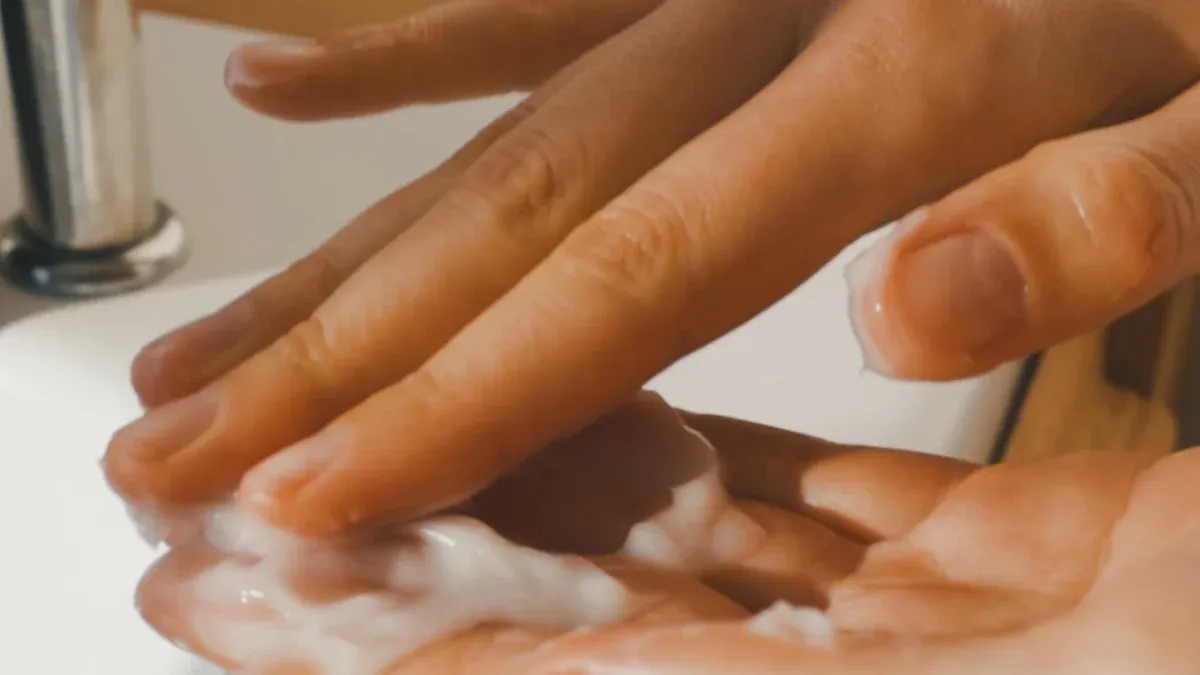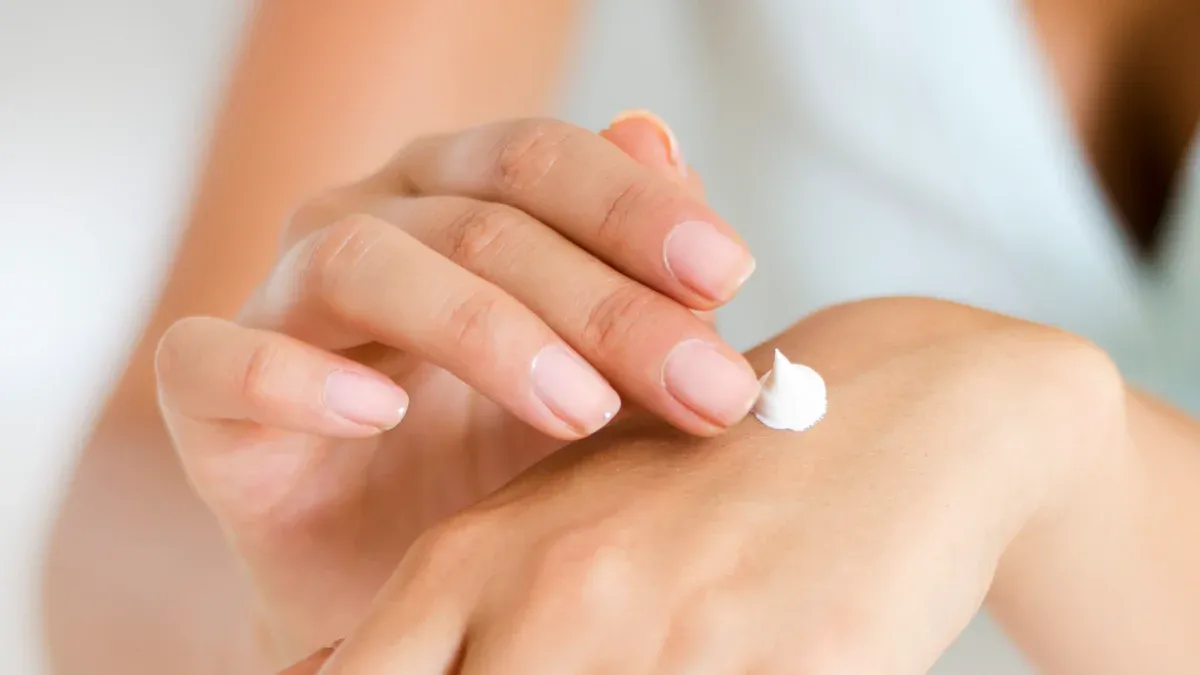You can expect working hands cream to keep your hands moisturized for several hours. Washing your hands, doing manual work, or spending time in dry air can make the effects fade faster. If you want your hands to stay soft and protected, pay attention to your daily routine. Try to notice when your skin starts to feel dry or rough. > Tip: Reapply whenever your hands lose their smooth feel.
Key Takeaways
Working hands cream keeps skin soft for a few hours, but you need to put it on again after washing or doing hard work. Apply the cream to damp hands right after washing and before bed for the best results. Put more cream on if your hands feel dry, rough, tight, or if you see cracks or flakes. This helps keep your hands safe. Washing hands a lot, doing tough jobs, dry air, and your skin type can change how long the cream works and how often you need it. Use warm water, mild soap, and try wearing cotton gloves after using the cream to help it work better.
Duration of Working Hands Cream
Average Effect Time
You may wonder how long working hands cream keeps your skin feeling soft and protected. Most people notice that the moisturizing effect lasts for several hours. If you use O'Keeffe's Working Hands, you might see visible improvement after just one night. Many users share that the cream works overnight to deliver deep hydration and healing. The benefits continue with regular use, especially if you apply it before bed. You will likely need to reapply after washing your hands or doing tasks that remove moisture.
A single container of hand cream can last for weeks or even months. The exact time depends on how often you use it and how much you apply each time. If you use a small amount and massage it in well, you will make the most of each jar.
Tip: Keep your hand cream in a spot where you see it often. This helps you remember to use it regularly.
Daily Use Tips
You can get the best results from your hand cream by following a few simple steps. First, wash your hands with lukewarm water. Hot water can strip away natural oils and make dryness worse. After washing, pat your hands dry but leave them slightly damp. This helps lock in hydration when you apply the cream.
Here are some easy tips for daily use:
Wash your hands with lukewarm water.
Apply hand cream right after washing, while your skin is still a bit damp.
Use a small amount if the cream feels rich.
Massage the cream into your hands until it fully absorbs.
Reapply after any activity that dries out your skin, like washing or working with your hands.
Apply before bedtime to boost hydration and healing overnight.
O'Keeffe's Working Hands and other quality creams work best when you use them at the right times. Nighttime is especially helpful because your skin repairs itself while you sleep. Regular use keeps your hands soft, smooth, and protected from dryness.
Note: Consistent use of hand cream helps maintain hydration and prevents cracks or rough patches.
Factors Affecting Hand Cream Longevity
Hand Washing
Frequent hand washing can remove the protective layer that hand cream creates. When you wash your hands often, you may notice your skin feels dry or tight more quickly. Many people who work in jobs like healthcare or food service wash their hands many times a day. This can lead to dryness and even cracks. Experts recommend applying hand cream after each wash to keep your skin healthy. Some creams, like Cicaplast, are made to last through several washes, but most creams, including working hands cream, work best when you reapply them after washing.
Washing hands often can damage the skin barrier.
You should use hand cream after each wash to restore moisture.
If your hands feel rough or cracked, it is time to reapply.
Tip: Keep a small tube of hand cream near your sink or in your bag for easy access.
Activity Level
Your daily activities also affect how long hand cream lasts. If you do manual work, gardening, or use cleaning products, you may notice the cream wears off faster. Activities that involve water or friction can remove the cream from your skin. You should reapply after these tasks to keep your hands protected and soft.
Skin Type
Your skin type plays a role in how your hands absorb and hold onto moisture. If you have dry or sensitive skin, you may need to use hand cream more often. People with oily skin may find that the cream absorbs quickly and feels light. Most modern creams, including those that are fragrance-free and hypoallergenic, work well for all skin types. You can use them safely even if you have eczema or diabetes. The key is to listen to your skin and apply more when you feel dryness.
Environment
The environment around you can change how long your hand cream works. Cold weather, dry air, and wind can make your skin lose hydration faster. In winter or in places with low humidity, you may need to apply cream more often. Dermatologists suggest using a thicker layer at night or when the air is very dry. This helps lock in moisture and keeps your hands comfortable.
Note: Adjust your hand cream routine based on the season and your surroundings for the best results.
When to Reapply Working Hands Cream
Signs of Dryness
You need to watch for signs that your hands are losing moisture. Dryness often shows up as rough patches or a feeling of tightness. Sometimes, your skin may start to itch or look dull. Cracks or flaking can also appear when your hands need more hydration. If you notice any of these changes, it is time to reach for your hand cream.
Here are some common signs that tell you to reapply:
Your skin feels tight or uncomfortable.
You see small cracks or flakes.
Your hands look dull or rough.
You feel itchiness or irritation.
Tip: Check your hands after washing or working. If they do not feel smooth, add more cream.
Loss of Protection
Working hands cream creates a barrier that helps protect your skin. This shield can wear off during the day, especially if you wash your hands often or use cleaning products. When you lose this protection, your skin becomes more vulnerable to dryness and damage.
You can test the barrier by rubbing your hands together. If they feel dry or rough, the cream has worn off. You may also notice that water does not bead up on your skin anymore. This means you need to reapply to restore the protective layer.
A simple table can help you remember when to reapply:
Situation | Should You Reapply? |
After washing hands | Yes |
After manual work | Yes |
Before going outside | Yes |
Before bedtime | Yes |
Note: Regular use of hand cream keeps your skin healthy and comfortable.
Maximizing O'Keeffe's Working Hands Results
Application Techniques
You can get better results by using the cream the right way. First, wash your hands with lukewarm water and gentle soap. Dry your hands, but let them stay a little damp. This helps the cream keep your skin moist. Put a small amount of cream on your hands. Rub it in until your skin soaks it up.
When you use the cream matters a lot. Put it on after washing your hands and before bed. These times help the cream protect your skin longer. If you use the cream before or after work, your hands can heal and stay safe. People who use their hands a lot, like nurses or mechanics, say the cream keeps their hands soft all day if they use it after washing. You can also put on the cream during breaks or after work. This stops your hands from feeling greasy when you use tools.
Tip: Use the cream every night before bed. This helps your skin feel better and heal while you sleep.
Protective Habits
You can make your hand cream work better by changing a few habits. Do not use hot water to wash your hands. Hot water takes away your skin’s natural oils. Pick a soap that adds moisture, like one with lanolin or glycerin. Be gentle when you wash and pat your hands dry instead of rubbing.
Put on your hand cream right after you wash, while your skin is still damp. For extra help, wear cotton gloves after you put on a thick layer of cream. Keep the gloves on for about 30 minutes. This lets the cream soak in and helps fix dry, cracked skin faster.
Habit | Benefit |
Use lukewarm water | Stops your skin from drying out |
Moisturize after washing | Keeps water in your skin |
Wear gloves after application | Helps the cream work better |
Doing these things with o'keefe's working hands keeps your skin healthy. This works even if you wash your hands a lot or have a tough job. Studies show that using hand cream, gloves, and good washing habits can stop skin problems and keep your hands feeling good.
Working hands cream keeps your skin moist for a few hours. Many people notice better skin in just a few days. Almost all users, about 97%, are happy with how it works. You should change how you use the cream if your day or weather changes. These tips help your hands stay soft and healthy.
Feedback Aspect | Details |
User Satisfaction | About 97% satisfied |
Visible Results | 2-3 days for many users |
Lasting Effects | Sustained with regular use |
Remember: Using hand cream often gives you the most comfort and keeps your hands safe.
FAQ
How often should you apply working hands cream?
You should apply working hands cream after every hand wash, after manual work, and before bed. If your hands feel dry or rough, use it again. Regular use helps keep your skin soft and protected.
Can you use working hands cream on other parts of your body?
Yes, you can use working hands cream on elbows, knees, or feet. The formula works well on rough or dry skin anywhere. Avoid using it on your face or broken skin.
Is working hands cream safe for sensitive skin?
Most people with sensitive skin can use working hands cream. The formula does not contain strong fragrances or harsh chemicals. If you have allergies, check the label or test a small area first.
Does working hands cream leave a greasy feeling?
No, working hands cream absorbs quickly. Your skin feels soft and smooth, not greasy. You can use your phone or keyboard soon after applying.
Tip: For best results, massage the cream in until fully absorbed.
English
العربية
Français
Русский
Español
Deutsch
italiano
日本語
한국어
Nederlands
Tiếng Việt
ไทย
Polski
Türkçe
Bahasa Melayu
ဗမာစာ
தமிழ்
Filipino
Bahasa Indonesia
magyar
Română
हिन्दी
فارسی
Norsk
Svenska
українська
Suomi
Latine
اردو
বাংলা
Gaeilge
Беларуская мова
Bosanski
Български
guarani
Македонски
മലയാളം

















